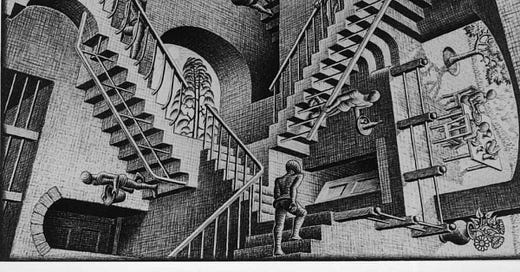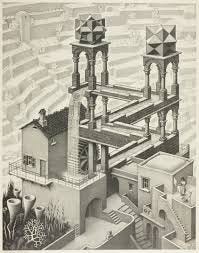Impossible Objects
Roger Penrose, a mathematician, and Nobel Laureate in Physics came upon the artwork of M.C. Escher in 1954 while attending a conference in Amsterdam. He was amazed at the confusing array of objects and people in a particular piece of work titled Relativity. In Escher’s Relativity figures appear to ascend and descend on the same staircase. Other figures emerge from steps in the floor while another figure approaches this same plane as if it were their wall. It is hard to tell which is up and which is down resulting in a skewed perspective and as the title suggests it is relative to the onlooker’s point of view. Relativity was not the only piece to strike the young mathematician as intriguing. There were other variations in Escher’s art to suggest that objects could appear rational in two dimensions but if brought to life would be an act of futility as no-one could build them in three dimensions.
When Penrose returned home, he told his father what he saw. The concepts equally intrigued his father, Lionel Penrose, who, as a successful and noted psychologist, found them to be intriguing exercises in understanding how human perception can be faulty and transform our judgements. Both father and son toyed with ideas for creating new two-dimensional shapes that appear realistic on paper but could not be built. After trial and error, Roger managed to draw a triangle which upon initial sight appears to be normal but if one were to trace their finger along the edges to each corner, they would soon find that the shape could not exist. Roger Penrose called his optical illusion an “Impossible Object.” Impossible Objects are conceptualized items rendered in two-dimensions but avoid construction as a three-dimensional object. They serve no functional purpose and are meant only to amuse.
Inspired by his son, Lionel Penrose, using wood and glue, built an impossible staircase. Penrose’s impossible staircase is a series of steps that when viewed from a certain vantage point gives the appearance that a individual is both climbing up and climbing down in a continuous loop. In fact, the stairs, when viewed from any other angle, show that the steps are not continuous, and fail to connect at the lowest point.
In 1958 Lionel and Roger Penrose published a scientific paper in the Journal of Psychology explaining their findings. Lionel sent this paper to M.C. Escher who was astounded by the revelation of the never-ending staircase. In turn, M.C. Escher sent the Penrose’s a copy of a print titled Ascending and Descending which incorporated Lionel’s impossible staircase, with twenty-five ambling figures walking its path hunched over as if in a fit of exhaustion. Years later, Escher devised another work of art, Waterfall, in which a stream seems to plummet to the bottom and then flow to the top in a series of five channels only to plummet again. In this work, Escher had included and manipulated Roger Penrose’s impossible triangle.
It was not just the water ways and staircases that flowed in a continuous loop. Ironically, it was Escher who had influenced the Penrose’s and now the Penrose’s had inspired Escher. They were in their own continuous loop of curiosity and creativity with geometry.
As much as Escher influenced the young mathematician, he was not aware of why and how the illusions worked. As he once explained he never received a passing grade in math and did not understand the mathematical theories of the impossible objects when explained to him. Despite this fact, Escher’s artwork still proves to be important to mathematicians. His attention to detail and attractive patterns inspires mathematicians to use illustrations to help explain their complex theories.









